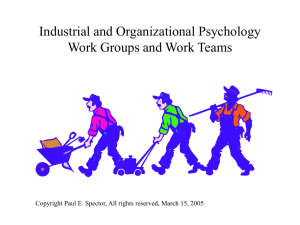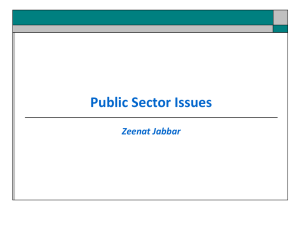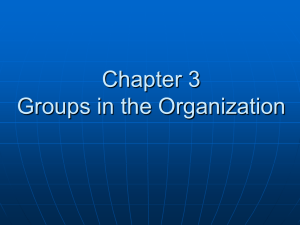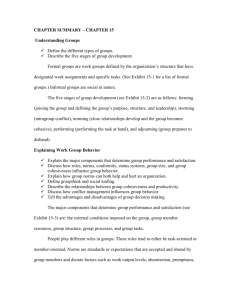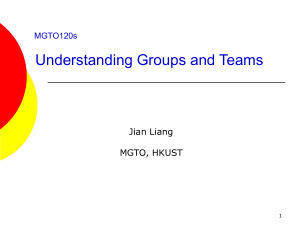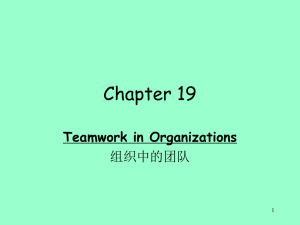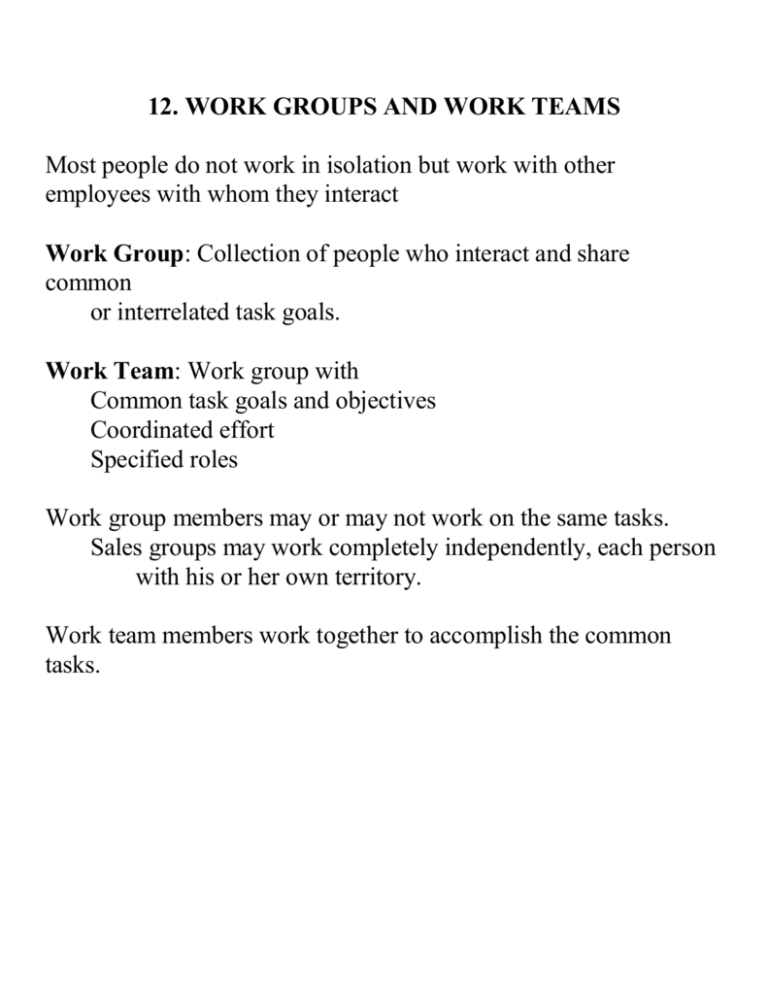
12. WORK GROUPS AND WORK TEAMS
Most people do not work in isolation but work with other
employees with whom they interact
Work Group: Collection of people who interact and share
common
or interrelated task goals.
Work Team: Work group with
Common task goals and objectives
Coordinated effort
Specified roles
Work group members may or may not work on the same tasks.
Sales groups may work completely independently, each person
with his or her own territory.
Work team members work together to accomplish the common
tasks.
GROUP/TEAM CONCEPTS
Roles
Specialization of function within positions
Formal: position title and description define with job
analysis
Informal: Emergent behavior in group
Status
Power & influence, prestige, respect
Partially inherent in role
Example
Torrance study of B-26 crews
Horse trading problem
Buy a horse for $60 and sell it for $70
Buy it back for $80 and sell it again for $90
How much profit did you make? (Answer at end)
94% pilots, 80% navigators, 63% gunners convinced crew
they had correct answer, which is in order of their status
Norms
Expected & accepted behavioral standards
Productivity norms
Dress norms
Group Cohesiveness
Attraction of group members toward staying in group
High cohesive groups
Lower turnover
Stronger adherence to norms (homogenizer of behavior)
Greater satisfaction
Greater group influence
Study
Purcell (1953)
Allow construction workers (carpenters & masons)
choose own partners
Results
5% reduction in costs (labor & materials)
87% decline in turnover
Team Commitment
Strength of an individual’s involvement in team and acceptance
of team goals
Team Mental Model
Shared understanding of task by team members
Process Loss
Effort/time spent by team members on non-task activities
See discussion below
GROUP PERFORMANCE
Individual vs. group
Individual tasks in work groups: coacting effects
Social facilitation
Competition and arousal (audience)
Social inhibition
Distraction
Group processes
Arousal
Group tasks: interdependence of group effort
Assembly line: Performance = f(poorest individual)
Additive: Performance = f(sum of individuals)
CLASSIC STUDY OF PAJAMA FACTORY
Coch & French (1948) Overcoming resistance to change. Human
Relations, 1, 512-532.
Harwood pajama factory
600 Employees
5/6 women
Piece rate for over standard (60/hr.)
Some jobs take average 34 weeks to reach standard
Frequent production changes: transfer bonus given
Only 38% return to standard after a production change
Low productivity after changes
High turnover after change (12%/mo vs. 4.5% for nonchanged)
Poor attitude, high absence after change
Cohesiveness & change
High cohesive, + attitude, best relearners
Low cohesive,
Intermediate
High cohesive, - attitude, worst relearners
Effects of Group Pressure. Productivity of one operator in a
group with a production norm of 50 units per hour.
Days
Productivity
Event
1-12
13-20
21-24
25-40
46-56
55-48
45-96
92
Joins group
Pressure begins
Group disbanded
Working alone
Overcame resistance by allowing workers to participate in change
decisions
Better performance
Less turnover
GROUP PERFORMANCE VS. INDIVIDUAL
How does group compare to sum of individuals?
Additive task (Kravitz and Martin, 1986) rope pull
Number of people
Predicted force of
Actual force of pull
pull
1
1
1
2
2
1.86
4
4
3.08
8
8
3.92
Social Loafing
Identifiability reduces social loafing
Assembly line: Performance only at level of worst performer
Brainstorming (creative task)
Group inhibits individual performance
PROCESS LOSS
Time spent in group maintenance
Enforcing norms
Building cohesiveness
Solving interpersonal problems
Lack of coordination
Power struggles
Distraction
Conflicting goals- splitting of effort
GROUP INTERVENTIONS
How should we work with groups?
to increase productivity
to increase satisfaction
to make work more meaningful
Increase cohesiveness
Encourage formation of work groups
Allow socialization, on & off the job
Assign group tasks
Give group rewards
Allow employees to select coworkers
Make group and organizational goals compatible
Group rewards
Profit sharing
Participation
Team building
Goal of building efficient work groups
Series of exercises & experiences with a trainer
AUTONOMOUS WORK GROUPS (HACKMAN &
OLDHAM, 1980, WORK REDESIGN)
Self-managed work team makes entire product
Work group has almost total authority
Butler Example (Grain Dryer, over 3000 parts)
Job rotation frequent & controlled by group
By end of 18 months most employees know entire process
Groups design, develop & purchase own tools
Service calls throughout area (meet customers)
No quality inspectors (done by group)
Few foremen (forepersons)
Groups participate in hiring & promotion
Supervisors as coaches, counseling & training
Many meetings: weekly team, monthly plant
Participative: Employee advisory group
Training in interpersonal skills
Results
Absence 1.2% (vs. 5% for factories in general)
Turnover 11% (vs. 35% for factories in general)
Profits higher than expected
Note: Horsetrading answer is $20. Forget it is the same horse, but assume you buy two horses for $60 and $80, and you sell them for $70 and $90, respectively. The total
profit is $10 or each transaction or $20. You spent $140 on horses and their sales returned $160. The fact it was the same horse doesn’t change that.
Copyright Paul E. Spector, All rights reserved, July 22, 2002.




